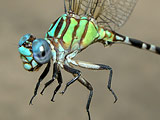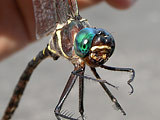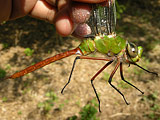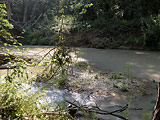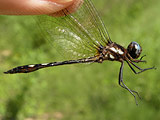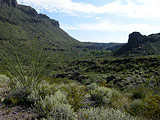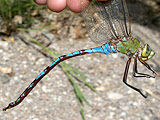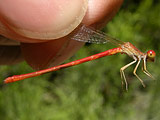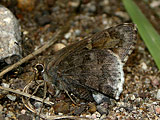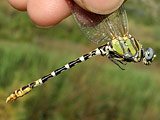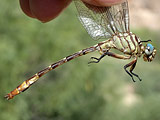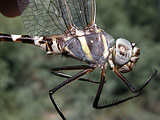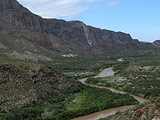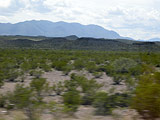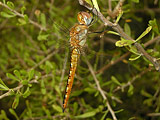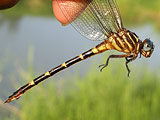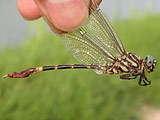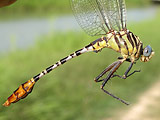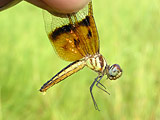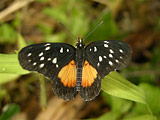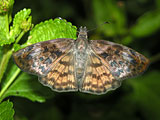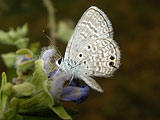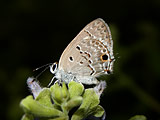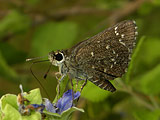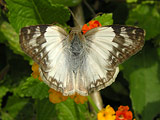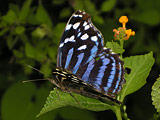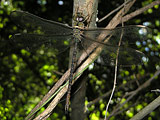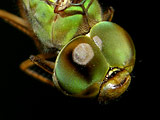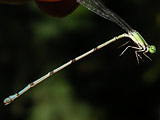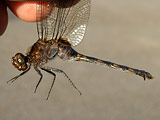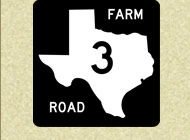
Texas Take Three
August 28 - September 7, 2008
The dragonfly list for Texas is varied and long. It is full of rarities. Should you aspire to add a new species to the U.S. list, Texas is probably where you should go. This year offers some extraordinary evidence of this with 5 new species found including the Bow-tailed Glider Tauriphila argo that Fabrice de Lacour and I found in June. So bring a camera (and a net where you are able to swing one) and head for the border.
Following up on my June visit, I flew to Austin on August 28th. I met with Greg Lasley and we drove out to Hornsby Bend in the mid-afternoon. It was hot and there wasn't a lot flying but we hoped beyond reason for a rare Amazon Darner Anax amazili that had once been recorded here. I waved my net weakly at a River Cruiser Macromia sp. flying along the road and declared how rusty I was. We headed back to Greg's house, watched the Cubs come back to beat my Phillies and kept an eye on the track of Hurricane Gustav.
Friday, August 29: COME AND TAKE IT.* Greg took me to Independence Park in Gonzales to look for another Texas rarity, Blue-faced Ringtail Erpetogomphus eutainia. This beautiful little clubtail is strikingly patterned with a black and white ringed abdomen with a russet tip, a green and aqua thorax striped with black, dark blue eyes, and a bright blue face. A few years ago Greg went on a quest to refind the species in Texas, checking the few historical sites mostly on the San Marcos River. After being turned away from one possible location due to storm damage, he stopped on the way home at a little city park along the Guadelupe River. Here he managed a rear view photograph of a female before it flew away through the brush. This location was now the only reliable place for the species in the U.S.
We were a little worried to see a backhoe clearing brush along the river when we arrived. Greg's best spot is a little grassy knoll where ringtails often forage in the morning. Ten feet from a parked bulldozer we saw our first ringtails. We saw about 10 individuals low in the wet grass. It was just 10 AM and we had already hit our target. I wanted to take some field photographs but when I pulled out my camera the battery was dead. The camera must have switched on and the battery drained during my travel day, at least I hoped that was the extent of the problem.
We then tried some of the historical spots for Blue-faced Ringtail along the San Marcos. One of them was a spot where Greg once found a Ivory-striped Sylph Macrothemis imitans, another Texas rarity. We didn't find too much, Russet-tipped Clubtail Stylurus plagiatus was fairly common. At the sylph spot a woman was taking a cooling dip with her aged dog.
*Greg treated me with some history regarding Independence Park in Gonzales. In 1831 a small cannon was granted by the government of Mexico to colonists in Gonzales to repel indian attacks. Later with animosity building between the settlers and Mexico, the Mexican government ordered the cannon be returned. The Texans replied, "Come and take it!" A Mexican Army detachment of one hundred men were sent to repossess the cannon. A small band of 18 Texans armed with the cannon prevented the Mexicans from crossing the Guadelupe River on September 29, 1835. After gathering reinforcements, the Texans repelled the Mexicans on October 2, the first skirmish of the Texas War of Independence. "Come and take it!" would become a popular slogan. With a somewhat different meaning, it is still used by the NRA today.
Saturday, August 30: We drove north to Waco to look for Gilded River Cruiser Macromia pacifica. We knew it was a long shot, the locations we had were from sightings made over 30 years ago. A lot can change, a quiet little road over a stream often becomes a four-lane highway with no access to the water. Streams and rivers rarely change for the better, sometimes they are re-channeled, or become silted, and more polluted.
We found access to all the locations. Three were on the Bosque River where I did catch a river cruiser but it was a Royal River Cruiser Macromia taeniolata. I knew it was not our target even in flight, it being comparably darker without the large yellow spots that would mark a Gilded. Another location was Hog Creek. The water levels were low, reducing the stream to a series of pools linked by trickles over rock. There were Common Pondhawks Erythemis simplicicollis and Eastern Ringtails Erpetogomphus designatus but no river cruisers were seen.
On our way back to Austin we tried Hornsby Bend again. In Greg's truck we drove the dirt roads hoping to flush up a good dragonfly. A darner flew out of the trees. I followed it into the brush where it hung up, a male Comet Darner Anax longipes.
Sunday, August 31: I planned Sunday as a travel day to head west to get to the Big Bend area. But beforehand I had a list of locations provided by Greg and Martin Reid to look for Ivory-striped Sylph. I headed to the closest one, a park on the Medina River in San Antonio.
I got there early. The river was mostly shaded by the woods along the banks. I walked the trail along the river stopping to scan the water at every access. At one point there was a little gravel bar. Most of the river had been deep and swiftly flowing so this was one of the few places you could get safely on the water. Eastern Ringtails hovered below the riffles. Out over the water a couple of more ringtails hovered and chased each other. Oddly their thoraxes looked bright green. Usually Eastern Ringtails look yellowish or sometimes a pale green. I thought the effect might be due to the lighting conditions, the shade deepening the colors. I trained my binoculars on one. It faced the riffle away from me and the thorax sure looked bright green. Then it turned and hovered. Was that a blue face?
Convinced they were Blue-faced Ringtails, it took me a while to net one. I wanted to get at least a photographic record as the Medina River would be a new location and a new county record for this rare species. I saw at least a dozen males on the river hovering and chasing each other and other species at the top and bottom of the riffles. I observed a female being tackled into the water before being taken into tandem and flying up into the trees. (Interestingly, Greg Lasley visited the site on September 10 and did not see any Blue-faced Ringtails. From what I observed they should still be there. It may have been a little cloudier than my visit but it shows how little we know about the habits of these species.)
I turned around and worked back along the river still hoping for Ivory-striped Sylph. It was late in the morning and more sun was reaching the river. I walked through a little clearing along the water. From the vegetation a small dragonfly flushed up and re-landed. It was a male sylph, its blue eyes catching the sunlight. Although it did not fly fast, it was hard to follow and I lost it. I hoped it did not go far.
Working my way around some bushes, a Sylph flew towards me. It landed briefly but I lost it again in the vegetation. I cursed as I combed the bank. Later I spotted a sylph (the same one perhaps) making short patrols over the water but on the far side of the stream. With the current flowing fast and deep, there was no way of getting any closer and I thought I had lost my opportunity to catch one.
Turning away from the water I spotted a small dragonfly flying back and forth at the edge of the clearing. It was another sylph and I managed to net him. Later I saw a few more foraging in the clearing and caught another male. I decided to work the river trail again. In another little open area another sylph foraged head high. I netted it and was happy to have found a female.
It was close to 1 PM and I had to get on the road. With the success of finding the sylph and the ringtail, I did not mind spending so much time at the park. I did forgo the other locations I intended to try and just headed west. I jumped on I-10 and made it all the way to Presidio by 8 PM, some 475 miles away.
Monday, September 1: For an East coast city kid, the endless western landscape is appealing but also daunting. In this harsh and rugged world you don't want to be without water, you don't want to run out of gas, and you don't want your car to get stuck going down sixteen miles of eroding dirt road.
The main road through Big Bend Ranch State Park is marked on the map as being graded. Much of it has been re-graded recently after heavy rains have sent water washing over the road at several points. But they haven't gotten to every washout so traveling can be dicey for a compact car with low clearance. Scary soft sandy stretches, scraping rock strewn stretches, and deep ruts. I drove slowly and kept moving. My goal was Ojito Adentro, a spring with a series of grotto-like pools shaded by trees, an oasis in the desert that must have been both welcome and lifesaving for past travelers. Now it is the only reliable place in Texas for Mayan Setwing Dythemis maya, a fiery red dragonfly and my reason to visit.
I arrived shortly before 11 AM, walking the trail and clamoring over rocks to get to the spring. It is a beautiful spot and the Mayan Setwings were plentiful. Unfortunately the only female I saw was chased away by a male and over 4 hours I did not see any others come down to lay eggs. While I waited I took note of the other odonates here. Similarly red Neon Skimmers Libellula croceipennis looked liked the setwings' grown-up cousins. There were three species of dancer Argia but Giant Darners Anax walsinghami were the highlights of the show. North America's largest dragonfly, males made the rounds of the pools hoping to find a female ovipositing along the vegetated edges. I stayed until 3 PM when the male Mayan Setwings had all but left the water then made the long slow drive out of the park.
Tuesday, September 2: After the previous day's long vigil, I decided against trekking back to Ojito Adentro and hoping for a female Mayan Setwing. I only had a limited time for this trip and I still had a long way to go. Instead I spent the morning along the Rio Grande River. Usually it's a small stream this far west but recent rains had swollen it. The water was muddy and thick, roaring and churning through the narrow valley. I did not feel any compulsion to get real close to it but I did observe a couple of male American Rubyspots Hetaerina americana perched above the flood.
Heading east I stopped at a couple of river access points along FM 170, a scenic road winding along the river. Searching among the brush I was hoping for Brimstone Clubtail Stylurus intricatus which has been rarely seen in the area. I did not find any. As consolation I found several Russet-tipped Clubtails of the western form. These look very different from those in the East and even those in the lower Rio Grande Valley so much so they could easily be mistaken for a different species. Also present was a variation of Eastern Ringtail with an almost complete anterior dark shoulder stripe. I caught a single Bronzed River Cruiser Macromia annulata that hung up in a nearby tree. I also caught a lone clubskimmer feeding along the shore. I was hoping it would be a rarity but it was a common Pale-faced Clubskimmer Brechmorhoga mendax.
With more than half the day gone I continued east heading for my next destination, the lower Rio Grande Valley. Hurricane Gustav had come ashore in Louisiana and veered northeast so its effects would not be felt in the Valley. From where I was it is a 10 hour drive. I headed east into Big Bend National Park (paying $20 for the privilege of driving through), north onto 385, then southeast on I-90. I stopped halfway, spending the night in a motel in the town of Del Rio. After watching the movie No Country for Old Men I kind of wanted to see what Del Rio was really like.

While watching the movie last winter I was struck how the decor in one scene nearly matched my living room. The couches have the same fabric. There's a window behind and the curtains are similar. They all face the television. And I'm holding a bottle of milk. Weird.
Wednesday, September 3: The day was spent on the road and when I got to Bentsen LRGV State Park in Mission, it was already 3 PM. I looked around briefly but did not see many dragonflies flying near the visitor center. It was hot and more humid and I feared I would not be able to handle the mosquitoes. I am one of those people that they really love. With just a little repellent on I stepped into a wooded trail off of Old Military Highway. This was a good spot back in June but one where the mosquitoes were pretty bad. Just to find out how bad, I walked in and it sounded like someone turning up the volume, the whine of mosquito suddenly growing loud. I fled to the car and about 30 mosquitoes followed me inside. This wasn't going to be fun. I headed to the HEB and bought 2 cans of their strongest repellant.
Thursday, September 4: I started at Bentsen at 8 AM. I walked the canal and I saw what I thought was a Claret Pondhawk Erythemis mithroides. It flushed somewhere low to my right and flew across the canal. It landed briefly on the ground and I quickly crossed the bridge to get a closer look. However before I could it flew up into a tree and perched on some bare twigs. Through binoculars I could see its wings were somewhat tattered, a mature individual, but I could not get a definitive look. Could it be just a Red-tailed Pennant Brachymesia furcata and a lot of wishful thinking? It flew higher up the tree appearing to chase one of the many American Snout butterflies before disappearing over the top.
I walked the canal for some time afterwards. Dozens of Wandering and Spot-winged Gliders Pantala flavescens and hymenaea flew over the canal bridge. I saw Ringed Forceptails Phyllocycla breviphylla, Five-striped Leaftails Phyllogomphoides albrighti, Russet-tipped Clubtails of the blue-eyed eastern type, and Flag-tailed Spinylegs Dromogomphus spoliatus. Red-tailed Pennants were present but these didn't suggest Claret Pondhawks to me. Common (Eastern) Pondhawks landed at my feet and I wished a Claret would do the same.
I walked out to the La Parida Banco resaca where I had so much success in June. I needed to find out if the two species that were new to the U.S. were still flying and see whatever else was out there. I pushed through the cane and waded in. Red-tailed Pennants, Black Setwings Dythemis nigrescens, and Spot-tailed Dashers Micrathyria aequalis were still plentiful. There were still a few old looking Narrow-striped Forceptails Aphylla protracta around. But I did not see any Bow-tailed Gliders. If they persisted they were all larvae underwater. I did see the other rarity, a single male Scarlet-tailed Skimmer Planiplax sanquiniventris. It flew by a few times out of reach. I studied it hard not wanting to confuse the Red-tailed Pennants with it but the contrast between the red abdomen and the black thorax was strikingly different.
Back on shore I looked but did not find any Carmine Skimmers Orthemis discolor. I still need a female. I headed back to the visitor's center to make another Claret Pondhawk search. Clouds rolled in curtailing any dragonfly activity so I took the opportunity to photograph some of the many butterflies visiting the garden. Then it began to rain and I ducked into the visitors center. It stopped briefly then started pouring again. When it let up a bit I ran to the car and headed back to the motel. Just a few miles away the motel parking lot was not even wet.
Friday, September 5: I went to Santa Ana NWR in the morning. I had been granted a permit to sample odonates at the refuge but I had gathered very little data during my two previous visits. In April there were lots of common species like Great Pondhawk Erythemis vesiculosa and Striped Saddlebags Tramea calverti. In June the refuge was nearly dry and after one fruitless morning I did not return. I felt like I had to find something notable or I'll never get another permit from here again. It did not start very well. I walked the Pin-tail Lake trail out to the Rio Grande. There were common dragonflies, gliders, Common Green Darners Anax junius, Roseate Skimmers Orthemis ferruginea, and Band-winged Dragonlets Erythrodiplax umbrata. The most interesting species I bothered to catch was a female Slough Amberwing Perithemis domitia foraging in a field. I walked back towards the visitors center via the Chachalaca Trail where a darner flew overhead and hung up in a tree. Through binoculars I saw it was a rare Amazon Darner, its pale spots contrasting against a dark abdomen. It was too far away to net or photograph with my equipment. Then it flew off. I waited but could not relocate it.
It had grown hot so frustrated I went back to Bentsen to meet with Josh Rose who was leading a dragonfly walk. We didn't find anything different but I got to chat with him and Tom Pendleton for a while. Later I stopped at Anzalduas County Park where I saw the usual clubtails but nothing noteworthy.
Saturday, September 6: My last day in the field. Thus far the Valley had been a disappointment. One Amazon Darner I could neither photograph or catch. A possible Claret Pondhawk. It had been hot and humid and I had lost my enthusiasm. By now I was road weary, lonely, sleep-deprived, mosquito-bitten, congested from ragweed and air-conditioning. I was spending money but not making any progress. Burnt out.
I went to Santa Ana. I was pushing for Bar-sided Darner Gynacantha mexicana. This is a dark crepuscular species. If they acted anything like their cousin species the Twilight Darner Gynacantha nervosa, they would be roosting in deep shade during the day. I walked the Chachalaca Trail pausing at the spot where the Amazon Darner briefly perched. I flushed up Spot-winged and Wandering Gliders not yet on the wing. American Snouts were numerous and a little distracting. There were a few mosquitoes but not as many as I had feared. It turned out they weren't so bad in the mornings but got more active in the afternoon.
Peering into a thicket I saw the first Bar-sided Darner fly slowly and hang up. Protected by stems I could not get the net close to it before it flushed. In the horrible moment after you miss the first one, you wonder if that was your only chance and you blew it. On the other hand you think, if there was one there has to be more, right?
I got within an inch of the next one but failed to catch it as well. Again it perched where I could not maneuver the net so I slid my hand in to try to catch it by the wing tip. The first one I did catch was with my fingers, a female. Relief. After a while I got pretty good at guessing where a Bar-sided may be perched. It had to be heavily shaded, with lots of small branches. Thickets draped with spanish moss were often good. The darners showed little desire to be out in the open and would either flush out quickly or just flutter slowly and resettle.
Another darner flushed and I caught it after it hung up again. I thought it was going to be another Bar-sided Darner but when I extracted it from the net the thorax was green and fairly unmarked. A female Pale-green Darner Triacanthagyna trifida! There are only a handful of records for this species in the U.S. so it was a good find. I was starting to feel better about dragonflying.
I continued to poke around, flushing and photographing more Bar-sided Darners. In all I saw about 20. I had also flushed up several Black Witches, an impressively large moth which would flap around then re-land in the vegetation. One landed at the base of a small tree so was somewhat in the open, an opportunity to photograph it unobstructed. But as I moved in I noticed a damselfly perched on a blade of grass. It was slender with green on the thorax and blue at the abdomen tip. Furtive Forktail Ischnura prognata? I abandoned the moth and netted the damselfly. It was a female and not a Furtive, very long but not a spreadwing. I did not recognize it but figured it must be a female Cream-tipped Swampdamsel Leptobasis melinogaster (the female has yet to be described). I knew that the species had been found at Santa Ana in previous years but had wondered if they would still be present especially after such a dry summer. Six feet away I found a single male, unmistakable with a pale cream colored abdomen tip. The pale tip is about all you see as it flies through the shade. A couple of days later Jan and David Dauphin would follow up my report by finding and photographing more swampdamsels in the same area.
It grew hot in the early afternoon so I took a break and left Santa Ana. I went back to the motel and scanned the specimens. In the late afternoon I made one last trip out to Bentsen State Park. I was still thinking about the possible Claret Pondhawk and hoped to find him foraging on the ground. It was still plenty warm and sunny at 6 PM. I walked the canal but not far from the visitor center I could hear gunfire. The tempo of shots suggested target shooting. Through binoculars I saw a man and a boy holding rifles. Come and take it. Annoyed more than anything, I stayed clear.
On the road I saw a pondhawk but it was dark unlike the Claret. As I went to net it I hoped it might be a female Black Pondhawk Erythemis attala. It had pale spots on the abdomen but not as large or prominent as I would expect. An old one perhaps? It was an worn female Pin-tailed Pondhawk Erythemis plebeja. They were common in June but in September this was the only one I found.
Sunday, September 7: Got up early and made the last five hour drive back to Austin. After returning my dusty rental car my flights home were on pretty much on time for a change.
Many thanks to John Abbott, Greg Lasley, Cheryl Johnson, Martin Reid, David and Jan Dauphin, Josh Rose, and the staffs of Big Bend Ranch State Park, Bentsen LRGV State Park, and Santa Ana NWR. Thanks to David Riskind for granting permission to collect at Texas State Parks and Mitch Sternberg for permission to collect at Santa Ana/LRGV NWR.
